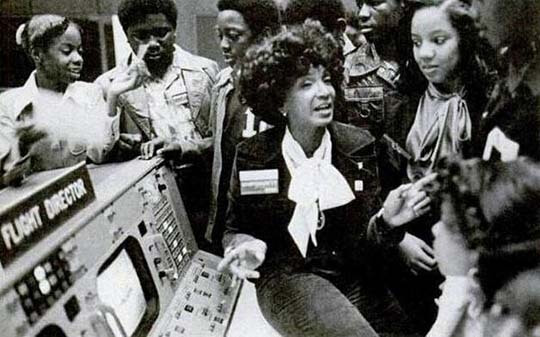What’s It About
In 1977, with just four months left, NASA struggles to recruit scientists, engineers and astronauts for their new Space Shuttle Program. That is when Nichelle Nichols, Star Trek’s Lt. Uhura, challenges them by asking the question: Where are my people?. She embarks on a national blitz, recruiting 8,000 of the nation’s best and brightest, including the trailblazing astronauts who became the first African American, Asian and Latino men and women to fly in space.



MOVIESinMO REVIEW
As I sat down to watch “Woman in Motion,” I had no idea how much this documentary would touch me. Directed by Todd Thompson, this 2021 film tells the amazing story of Nichelle Nichols, who is most famous for her groundbreaking role as Lieutenant Uhura on “Star Trek,” but her most profound impact on American history was after the series had concluded. The film connects Nichols’ early life as a singer and dancer, her famous Star Trek role, and her most significant achievement: leading a NASA recruitment program in the late 1970s. The program changed the space agency from white men to an agency that started to mirror the diversity of America. What catches my eye immediately about “Woman in Motion” is that it’s not some lightweight celebrity tale. Rather, it situates Nichols at the intersection of civil rights, space discovery, and media representation – and reveals how one powerful Black woman leveraged her platform to achieve tangible transformations within one of America’s leading institutions. The film does an excellent job of showing how Nichols went to a NASA function and saw that there were no minorities or women. She questioned the agency’s leaders directly and asked, “Where are my people?” When NASA authorities indicated that minorities were not applying, she did not take their excuses. Instead, she took it upon herself to conduct a recruitment campaign single-handedly. She was able to garner over 8,000 applications from minorities and women. Among the applicants were the first American woman in space, Sally Ride, and the first African American in space, Guion Bluford. Thompson’s writing is strongest when he compares old NASA footage from the early days (predominantly white men in short-sleeved shirts and narrow ties) with the multicultural groups of astronauts that began making appearances following Nichols’ work. These contrasts strongly show the “before and after” of her work, the manner in which representation can change organizations when there is real commitment to it. As a Black critic, I was particularly touched by the way the film portrayed Nichols’ concepts of symbolic representation. Her Lieutenant Uhura was more than a television character – she was a symbol of hope. When Martin Luther King Jr. urged her not to leave “Star Trek” when she thought about quitting, saying that she was creating a positive impression of Black competence and dignity for America, she knew firsthand how valuable visibility is. What’s so fascinating about “Woman in Motion” is how it shows Nichols taking this lesson and applying it not just to TV but to real areas of power and exploration. The film includes interviews with astronauts who pursued careers because they saw Nichols’ recruitment commercials or met her at events. The stories add an emotional gravitas to the statistics, as successful scientists and explorers openly share how seeing this Black woman encouraging diversity in space made them feel included as well. Every so often, the movie is flawed in terms of structure. The film jumps backward and forward throughout the different periods of Nichols’ life with scant narrative continuity, so that some transitions seem disjointed. Moreover, while the film portrays the struggles Nichols had as a Black woman in 1960s Hollywood, the movie could perhaps have explored such struggles more in order to shed more light on her later activist work on behalf of others. The film features commentary from such celebrities as George Takei and Walter Koenig, her “Star Trek” castmates, and younger space fans like Neil deGrasse Tyson. These observations add depth to the material, but the film is most powerful when it is focused on Nichols and the people whose lives were changed by her efforts to recruit others aboard. ” Woman in Motion” aptly demonstrates how critical it is that representation should be present not only on the big and small screens but also on positions of influence and in major discoveries. At the time when Nichols began collaborating with NASA, the notion of a Black female astronaut seemed more fictional than that of the starship Enterprise. By the final push of her endeavor, however, that fiction became reality, illustrating how imagination can convert into action through sheer determination. The strongest moments of the film feature Nichols in her seventies and eighties. She is still attending NASA functions, still advocating for inclusion, and still marveling at how much the space program has evolved in terms of diversity. These scenes convey the long arc of social change – that advancement requires both the initial breakthrough and the constant effort to evolve over decades. Especially for Black audiences, “Woman in Motion” is a unique story of institutional transformation wrought by a Black woman who did not take things as they were. While most documentaries address civil rights in broad areas like voting or access to education, the film looks at how the struggle for equality reached into the field of science and space exploration – areas not normally addressed when talking about civil rights history. The final third of the documentary, which deals with Nichols’ legacy as her health began to decline (she passed away in 2022), strikes the correct balance of celebration rather than elegy. It focuses on how her work opened doors that will continue long after her passing through the careers she launched and the precedents she set. “Woman in Motion” is not a perfect documentary. It does drag at times, and some background information would be better. Nevertheless, it does a great job of showing how a single, determined woman changed American space exploration. She believed that space was something that should be open to everyone to utilize, not only a privileged few. When the credits ended, I was so grateful that this story had now been correctly told. Nichelle Nichols’ efforts in promoting diversity in science and space exploration are a significant component of both civil rights history and American space history – one that needs to be as renowned as her iconic television role. “Woman in Motion” ensures that this incredible legacy will not be forgotten.
OUR RATING – AN UNSUNG HERO 9





